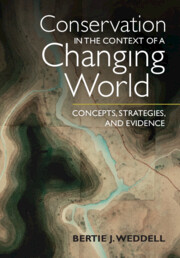Book contents
- Conservation in the Context of a Changing World
- Conservation in the Context of a Changing World
- Copyright page
- Dedication
- Contents
- Preface
- Acknowledgments
- Introduction
- Part I Maintaining Populations of Featured Species: A Utilitarian Approach to Conservation
- Part II Protecting and Restoring Populations and Habitats: A Preservationist Approach to Conservation
- 5 Historical Context
- 6 Central Concepts
- 7 Strategies
- 8 Strategies
- Part III Promoting Biocultural Diversity and Resilience: A Stewardship Approach to Conservation
- Postscript
- Appendix: Types of Ecosystems
- Bibliography
- Index
8 - Strategies
Protecting and Restoring Ecosystems
from Part II - Protecting and Restoring Populations and Habitats: A Preservationist Approach to Conservation
Published online by Cambridge University Press: 28 September 2023
- Conservation in the Context of a Changing World
- Conservation in the Context of a Changing World
- Copyright page
- Dedication
- Contents
- Preface
- Acknowledgments
- Introduction
- Part I Maintaining Populations of Featured Species: A Utilitarian Approach to Conservation
- Part II Protecting and Restoring Populations and Habitats: A Preservationist Approach to Conservation
- 5 Historical Context
- 6 Central Concepts
- 7 Strategies
- 8 Strategies
- Part III Promoting Biocultural Diversity and Resilience: A Stewardship Approach to Conservation
- Postscript
- Appendix: Types of Ecosystems
- Bibliography
- Index
Summary
To maximize opportunities for colonization and reduce the probability of extinction, Diamond recommended large, compact, closely spaced, connected reserves. However, species with limited ability to disperse and requirements for specific habitats found in small, dispersed patches may need several small reserves, and corridors may facilitate the spread of introduced species, diseases, or fire. Preserves in ecotones are likely to be valuable for organisms with low mobility as the climate changes. A coarse-filter approach to protection prioritizes ecosystems that contain high biodiversity, such as biological hotspots. In gap analysis, the distributions of selected taxa are compared to the locations of protected areas to identify priority areas for additional protection. Reserves may have a variety of levels of protection. Some conservation biologists advocate using the absence of human influence as the benchmark for strictly protected reserves. Restoration should conserve key processes, structures, and interactions such as fire in native prairie. Restoration should also address both abiotic and biotic elements of an ecosystem. Advocates of rewilding support the restoration of animals, especially megafauna, to their former ranges through reintroductions .
Keywords
Information
- Type
- Chapter
- Information
- Conservation in the Context of a Changing WorldConcepts, Strategies, and Evidence, pp. 196 - 220Publisher: Cambridge University PressPrint publication year: 2023
